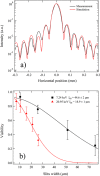The Extremely Brilliant Source storage ring of the European Synchrotron Radiation Facility
- PMID: 37124119
- PMCID: PMC10124696
- DOI: 10.1038/s42005-023-01195-z
The Extremely Brilliant Source storage ring of the European Synchrotron Radiation Facility
Abstract
The Extremely Brilliant Source (EBS) is the experimental implementation of the novel Hybrid Multi Bend Achromat (HMBA) storage ring magnetic lattice concept, which has been realised at European Synchrotron Radiation Facility. We present its successful commissioning and first operation. We highlight the strengths of the HMBA design and compare them to the previous designs, on which most operational synchrotron X-ray sources are based. We report on the EBS storage ring's significantly improved horizontal electron beam emittance and other key beam parameters. EBS extends the reach of synchrotron X-ray science confirming the HMBA concept for future facility upgrades and new constructions.
Keywords: Techniques and instrumentation.
© The Author(s) 2023.
Conflict of interest statement
Competing interestsThe authors declare no competing interests.
Figures








References
-
- The Nobel Prize in Physics 2021. https://www.nobelprize.org/ Nobel Prize Outreach AB 2022 (2022).
-
- Jaeschke, E. Synchrotron light sources and free-electron lasers: accelerator physics, instrumentation and science applications (Springer, Cham, 2020).
-
- Chasman R, Green GK, Rowe EM. Preliminary design of a dedicated synchrotron radiation facility. IEEE Trans. Nucl. Sci. 1975;22:1765–1767. doi: 10.1109/TNS.1975.4327987. - DOI
-
- Encyclopedia of Synchrotron Radiation Facilities, RIKEN Spring-8 Center (2020).
-
- Einfeld D, Schaper J, Plesko M. Design of a diffraction limited light source (DIFL) Proc. Part. Accelerator Conf. 1995;1:177–179. doi: 10.1109/PAC.1995.504602. - DOI
Publication types
LinkOut - more resources
Full Text Sources
